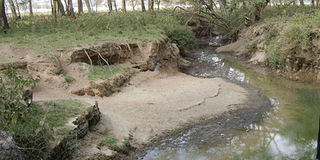Happening Now: Vetting of Gender CS nominee Hannah Wendot Cheptumo
Africa’s leaders must protect water towers

A drying section of River Njoro which was the main fresh water source for Lake Nakuru. Human activities in Mau Forest Complex threaten the key water catchment in the area.
World Water Day was commemorated on Saturday presented an opportunity for leaders and policymakers to confront the increasing vulnerability of Africa’s water towers.
Africa’s water towers, the high altitude ecosystems that are vital water sources, include the Angolan Highlands, Lesotho Highlands, Ethiopian Highlands, Guinea’s Fouta Djallon Highlands and Kenya’s Mau Forest complex. These critical ecosystems, vital for nourishing and sustaining the lives of millions across the continent, face unprecedented threats that could devastate water availability in and out of Africa.
Deforestation, unsustainable land use and climate change are rapidly degrading these critical resources. This is especially true for East Africa, where some of the continent’s most important water towers, among them mounts Kenya, Kilimanjaro, Elgon and Ruwenzori, the Ethiopian Highlands and the East African Rift, nourish rivers that flowacross international borders.
Of particular prominence is the Congo Basin, a colossal rainforest spanning six nations—the Democratic Republic of the Congo (DRC), Cameroon, the Republic of the Congo, Gabon, Central African Republic and Equatorial Guinea. The Congo Basin plays a crucial role in regulating rainfall and providing water to a vast region of Africa. Countries like Uganda, Rwanda, Kenya and even those farther away like Ethiopia, benefit from the rain cycles that are generated by the dense forests of the Congo.
The Congo Forest, unfortunately, is severely threatened by logging-driven deforestation, and clearing for agriculture and infrastructure development. This degradation has exacerbated the effects of climate change, causing increased unpredictability of rainfall and endangering water supplies for millions of people.
Deforestation
The need for joint action cannot be overstated. Deforestation in the Congo Basin not only weakens the global climate system but also jeopardises the livelihoods of people dependent on agriculture and water resources. Some of these communities live over 3,000 kilometres away, in places like Ethiopia, where shifts in rainfall patterns are already being felt, or in the Nile Delta in Egypt, which depends on the Nile River.
In East Africa, the effects of climate disruption on water towers have become evident in the past two decades. Water volumes in rivers, streams and springs are dropping at alarming rates, while the loss of glaciers from mountain peaks is a dire warning that East Africa’s water supply for agriculture, hydropower and domestic use will be compromised in years to come.
Mount Kenya and the Ethiopian Highlands, for example, are already seeing dwindling water volumes, affecting the livelihoods of communities that rely on glaciers, rivers and seasonal rains. This growing water crisis, if left unaddressed, has the potential to escalate into a regional water crisis that could also amplify challenges such as climate-induced conflicts and economic instability.
As East Africa grows in population and becomes more urbanised, water will become more critical to regional security and economic stability hence the need to protect these water towers not just as an environmental issue, but as a geopolitical and economic priority.
Trans boundary water towers
We are approaching a tipping point but we can step away from the precipice through bold and coordinated action.
First, we must prioritise the protection and restoration of transboundary water towers. Countries sharing water resources like the Congo and Zambezi basins need to jointly create and enforce policies that curb degradation and advance sustainable management.
Second, countries in Eastern Africa should ramp up investment in knowledge generation and dissemination together with climate-resilient infrastructure to enhance water availability, storage and use, and improve management systems. These investments should be designed to withstand the vagaries of climate change to sustain water supply for domestic, agricultural and economic growth.
Finally, governments and policymakers must think beyond bilateral agreements and instead focus on forging regional and international collaborations to finance the protection of Africa’s critical water towers. Safeguarding Africa’s water towers ought to be a collective priority—regionally and globally.
Dr Seid is the regional representative for International Water Management Institute for East Africa.

